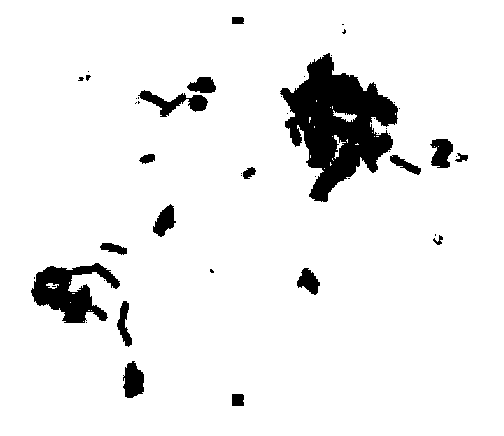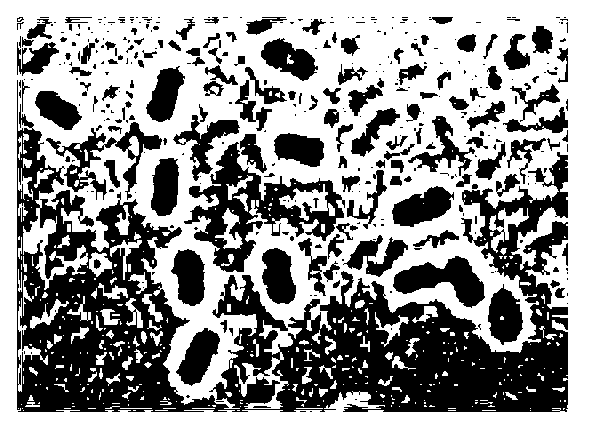Bacillus subtilis for controlling citrus canker
A Bacillus subtilis, canker technology, applied in the direction of chemicals for biological control, microorganism-based methods, bacteria, etc., can solve problems such as harming ecological safety and human health, enhancing drug resistance of pathogenic bacteria, and environmental pollution. Good control effect
- Summary
- Abstract
- Description
- Claims
- Application Information
AI Technical Summary
Problems solved by technology
Method used
Image
Examples
Embodiment 1
[0029] Example 1. Identification of Bacillus subtilis CCCQ080 strain
[0030] (1) Morphological observation and identification: culture the strain CCCQ080 on the NA culture plate at 28°C for 1-3 days, and observe the colony morphology (shape, color luster, whether the surface is raised or sunken, edge shape, etc.);
[0031] (2) Observation of physiological and biochemical reactions: Inoculate the strain CCCQ080 in the test medium for temperature, pH, salt tolerance, sugar alcohol fermentation, citrate utilization, nitrogen compound utilization, starch and other macromolecular compound decomposition and enzyme production, etc. observe the reaction;
[0032] (3) Molecular biological identification: extract the genomic DNA of the strain, use the bacterial universal primer fD1: 5'-AGAGTTTGATCCTGGCTC AG-3', rP1: 5'-ACGGTTACCTTGTTA CGACTT-3', and use the genomic DNA of the strain CCCQ080 as a template for PCR After amplification, it was detected by electrophoresis and sequenced; th...
Embodiment 2
[0033] Embodiment 2. Bacillus subtilis CCCQ080 bacterial strain disease control effect
[0034] 2.1 Bacteriostatic effect of CCCQ080 strain: inoculate the strain on NA plates, culture at a constant temperature of 28°C for 2 days, and spray 3×10 8 The cfu / mL suspension of X. citri was sprayed on the plate (about 100 μL / dish), and repeated 3 times. After culturing at a constant temperature of 28°C for 3 days, measure the diameter of the inhibition zone. To determine the inhibitory effect of CCCQ080 strain on citrus canker.
[0035] 2.2 Disease control effect of CCCQ080 strain
[0036] Detached leaf method: take some healthy sweet orange citrus leaves, wash the surface with distilled water, and dry. Soak in 75% ethanol solution for 30 s, then wash with sterile water and dry. The leaves were randomly and evenly divided into 4 treatments of A, B, C and D. In treatment A, only sterilized water was sprayed on the leaves; in B, only the fermentation broth of antagonistic bacteria ...
Embodiment 3
[0038] Example 3. Analysis of metabolites of CCCQ080 strain
[0039] 3.1 Detection of chitinase activity
[0040] Sole carbon source medium (Chi-Ayers): 1.0g ammonium dihydrogen phosphate, 0.2g magnesium sulfate, 0.2g potassium chloride, 20g agar, 1% colloidal chitin to 1000mL, pH: 7.0.
[0041] Preparation of colloidal chitin: Dissolve 20g of chitin in 350mL of concentrated hydrochloric acid, place at 4°C for 24h, filter through glass wool, add 2L of ice-free ethanol to the filtrate overnight at -20°C, centrifuge at 10,000 r / min for 20min, rinse with tap water Precipitate to neutral pH, freeze-dry, and store in a sealed seal at -20°C. When using colloidal chitin, grind it more than 5 times with a manual homogenizer.
[0042] Inoculate the antagonistic bacteria on the plate made of the above medium, culture at 28°C for 7-10 days, observe whether there is a transparent circle and measure the size of the transparent circle, if there is a transparent circle, it indicates that t...
PUM
 Login to View More
Login to View More Abstract
Description
Claims
Application Information
 Login to View More
Login to View More - R&D
- Intellectual Property
- Life Sciences
- Materials
- Tech Scout
- Unparalleled Data Quality
- Higher Quality Content
- 60% Fewer Hallucinations
Browse by: Latest US Patents, China's latest patents, Technical Efficacy Thesaurus, Application Domain, Technology Topic, Popular Technical Reports.
© 2025 PatSnap. All rights reserved.Legal|Privacy policy|Modern Slavery Act Transparency Statement|Sitemap|About US| Contact US: help@patsnap.com



